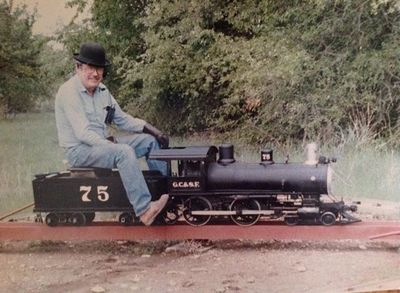Roy Pickard
Posted by Tom Stamey on TrainOrders.com, 13 January 2012:
IN the late 1970's Roy Pickard bought a ranch near Priddy, Tx. He went to Texas A&M to learn how to raise cows so that he could get a agricultural tax exemption on the land. His real purpose was to build a live steam railroad, the Comanche and Indian Gap. It would be spread over about 150 acres of rolling land, some heavily forested and other parts out in the open.
Roy and his son built about 80% of the railroad moving a lot of dirt and rocks to provide a right of way. Word spread about it and some came to see what he had done before it was finished. Some said he was crazy, others just thought he was a little nuts. But, in spite of that some started helping and the railroad main line was finished. It had to cross some creeks, one in particular called Cowhouse Creek which required a 120 ft bridge that ranged to a height of 10 ft over the Creek, and rise up some tough hills with plenty of curvature. Some parts such as the "raceway" allowed you to "come out" on the throttle if only for a 150 yards, then it was back to curves and grades.
Roy wasn't just building a live steam track, he was building a railroad complete with many passing tracks and sidings for freight trains to work. It was to be operated as a real railroad, dispatched by radio controlling train movements and meets. Roy made use of concealment of the track in wooded areas. In some places you would be close to another part of he mainline of the railroad and not even know it when trees and bushes were leafed out. The track ran from 3 terminals, West Yard, Comanche Yard, and Indian Gap each with a turntable and water spouts. It had tower 17, a tall structure that seated the dispatcher and a CTC machine for the Zuni (Tower 17) tracks and wye. It was the nerve center of the railroad. Radios were early Radio Shack 5 channel radios with only 1/4 miles range and not really good at that.
West yard had a return loop around it and Comanche would get one after friends collected money to hire a D-9 bull dozier to cut through 9 ft high rock infested ground and use the material for a fill on the loop. What Roy had unsuccessfully fought for years was done in a day by the dozier.
The mainline was 7200 feet one way and you ran out that far and back again for a total trip of 14,400 ft (2.72 miles). If you had a good trip, you could make it in about 1 hour round trip. If there was lots of traffic and meets you could take 2.5 hours to make a round trip. If you were on a local freight it could take a half-day.
The first meets were held in the early 1980's and continue to this day.
Word about this track spread quickly. Live steamers came from California, Arizona, New Mexico, Michigan, Wisconsin, Oklahoma, Missouri, Kansas, Mississippi, Florida, Georgia, Tennessee, Illinois, and even Alaska, to run on this track. It was totally unlike any they had ever run on. It was a "railroad". As a dispatcher I can remember one day when I had 18 trains running on the main at one time and I had only 9 passing tracks to work with. I doubled up a lot of them as 2nd sections and that cut my radio traffic in half. Thanks to long passing tracks it made two and sometimes even 3 sections possible. Still, it was a rather hair-raising experience. But, there were no "head ons".
Other larger and more involved live steam tracks have now been built in Michigan, Arizona, Oregon and a few others. FRS radios have made larger tracks more possible as have innovative signals. But, Roy Pickard's C&IG was the pioneer, the one that made others copy and improve upon the original. Yes the "crazy man", started it all and his legacy is secure.
Roy died April, 2012. I was privileged to ride a BNSF passenger train with him in Temple Tx 2 days before he passed away. He was in his 80's and I will never forget one of the last things he said to me. "Gettin old is the pits".
Roy's wife has said she will keep the meets going as long as she lives. All maintenance is now done by a small group of men who come to the track about 4 weekends a year plus all those who come to meets work on track Monday-Wednesday, and then run the rest of he week. The track's 31 year history has almost a complete turnover in those who now come to the meets. Many of the original group have passed away and others are so old now they just don't travel the long distances to get there anymore.

Posted by "Pontiacguy1" on Chaski.org, 26 April 2012:
- The Legends club for me would include Roy Pickard of Priddy, Texas. His was the first known railroad to be built with prototype operations as the goal. His C&IG railroad has been the inspiration for most of the railroads built afterward. In the 1960s, operating meant going in big circles and not hitting the train in front of you. Roy changed all of that. His track was built in 1972, and he and his sons did most of the work on the original lines by themselves.
References
- Comanche & Indian Gap Railroad
- "The Comanche & Indian Gap RR", Peter R. Bryan, Model Railroader, July 1997, Vol 64, Issue 7, page 74
- George Roy Pickard, obituary

